——— E ———
E – an archaic symbol for voltage and stands for electromotive force. It is still used extensively in formulas, although V is preferred.
e – the symbol for Euler's number, the base of the natural logarithm.
eAAC – see High Efficiency Advanced Audio Encoding.
eAACplus or eAAC+ – see High Efficiency Advanced Audio Encoding.
EAD – Equivalent Audio Distance.

ear buds – earphones with very small drivers housed in a small enclosures that fit over the ear canal (over-ear buds) or that slide into the ear canal (in-ear buds). Those that go in the canal help block out external sounds while those over the ear do not. Ear buds are notorious for producing poor sound quality, although some very expensive models are quite good. Sometimes spelled earbuds.
ear fatigue – a condition that occurs after extended time listening or working with audio, particularly at high levels. While this condition is not clinically recognized as a malady, audio professionals are keenly aware of its effects. It causes listeners to hear sounds differently than when using fresh ears. Also called listening fatigue.
earphones – see headphones.
early decay time (EDT) – the time that it takes for a audio signal to decay by 10 dB, based on a straight-line curve fit between the 0 dB and -10 dB points on the Schroeder curve, usually extrapolated to 60 dB of decay to be consistent with RT60. See reverberation time.
early, early sound (EES) – structure-borne sound that reaches a microphone before air-borne sound because sound travels faster through denser materials.
early reflections – the first reflected sound waves to reach a listener, variously defined as those arriving 20 to 50 ms or less after the direct sound. It includes the initial reflection, but does not include the late reflections. Early reflections bounce off of one or two surfaces and consist mostly of mid and high frequencies. When a reflection arrives in less than 50 ms, the ear does not perceive it as an echo, but it reduces the clarity of the sound and degrades stereo imaging.
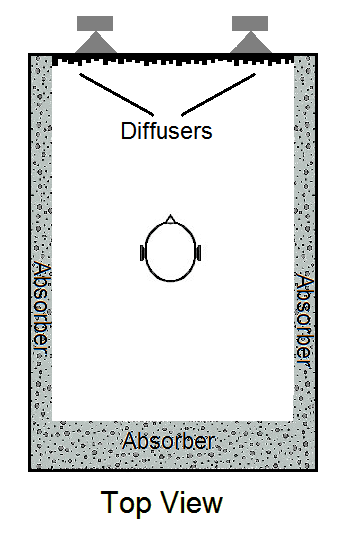
early sound scattering (ESS) – a control room design where the characteristic reflections are random and impose no character on the listening space. An ESS control room has a highly diffusive front end, which scatters the early reflections and an absorbent room, with damping for most of the low frequencies. These rooms have a flat frequency response and good stereo imaging, even in the rear corners of the room. Compare with LEDE, RFZ, non-environment, and controlled image designs.
ear speakers – see headphones.
earth – British term for ground.
earth ground – a physical connection to the ground (earth), usually made to a cold water pipe or a copper rod driven into the soil.
earth loop – British term for ground loop.
ear training – a skill in which musicians, engineers, and other audio professionals learn to hear and identify basic elements of music, such as pitches, frequencies, intervals, chords, rhythms, and other characteristics. Sometimes called aural skills.
earwig – a vey small in-ear monitor.
EASI – Enhanced Audio Streaming Interface. A communications standard developed by Emagic designed to standardize communications between software and hardware in professional audio applications.
Eastman Kodak Company – an American company founded by George Eastman in 1888 as a maker of photographic film. Headquartered in Rochester, New York, the company today is focused on imaging solutions and services for businesses. It provides packaging, printing, graphic communications, commercial films, and professional services. It is called Kodak for short.

E-Bow – a hand-held device that produces a magnetic field and when held over a string of an electric guitar produces a sound without plucking it, creating the effect of bowing the guitar string. The name comes from energy bow or electronic bow. Sometimes spelled EBow.
EBS technique – a stereo microphone technique, developed by Eberhard Sengpiel of the Berlin University of the Arts, that uses two cardioid microphones spaced 25 cm (9.8 inches) apart and at an angle of 90 degrees. Similar techniques use other angles, but 90 degrees is considered easier to set up. The EBS technique can be categorized in the near-coincident pair category of techniques. Other techniques in this category include A-B, DIN, ORTF, Faulkner array, NOS, RAI. See also coincident pair (Blumlein array, mid-side, X-Y pair) and spaced pair (A-B, Decca tree, spaced cardioids, spaced omnis). See table comparing various stereo microphone techniques.
EBU – European Broadcasting Union. An international professional society created in 1950 to solve technical and legal problems among the European broadcast community. It also establishes technical standards.
EBU Mode meter – in order to standardize meters that comply with ITU BS.1770, the European Broadcasting Union (EBU) in 2010 published EBU Tech 3341, a meter specification that provides for the EBU Mode. It specifies a meter that measures momentary loudness (measured over a 400 ms period), short-term loudness (measured over the last 3 seconds), and integrated loudness (which measures a program from start to stop), as well as a set of audio signals to test the meter.
EBU R128 – the standard established by the EBU for implementing audio loudness control for digital television under the ITU BS.1770 standard. This standard differs only slightly (primarily the target loudness level) from the US version under ATSC A/85.
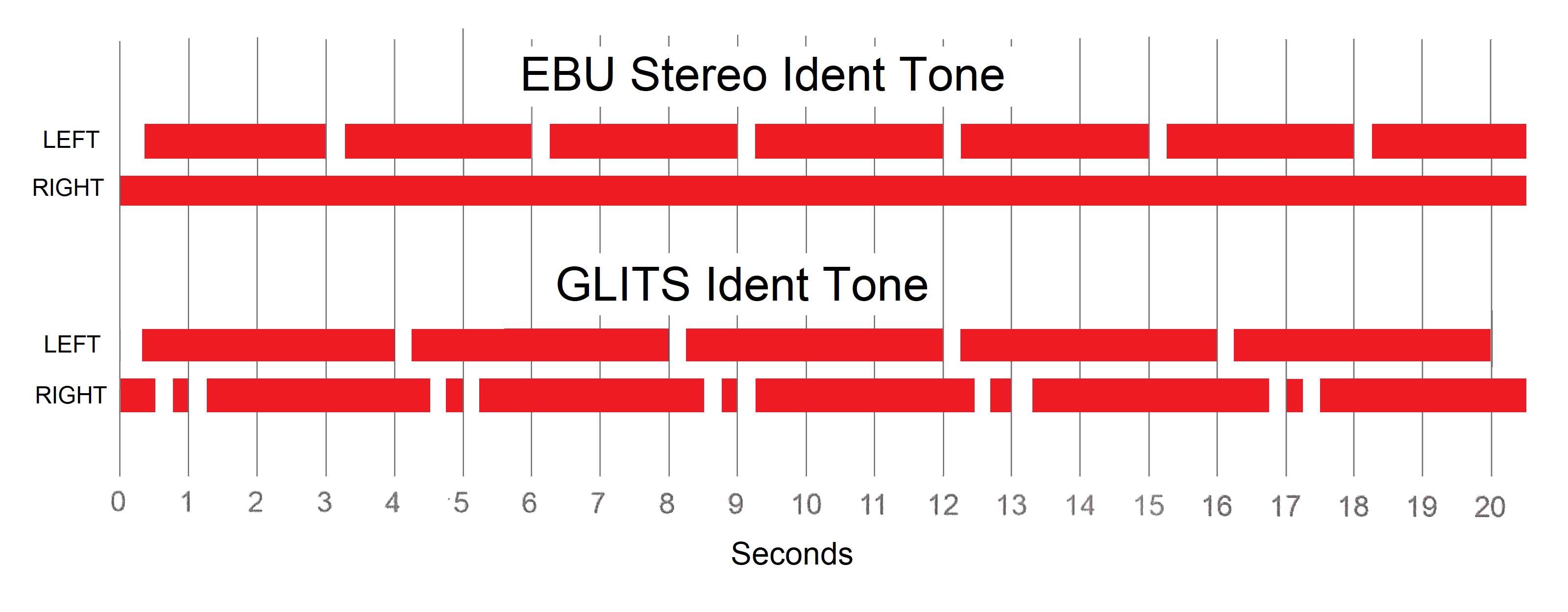
EBU stereo ident tone – a standard established by the EBU for identifying stereo audio channels, that consists of 1-kHz tone in both the left and right channels, with the left channel having a 250 ms interruption every 3 seconds. An improved version of this method is the
GLITS system which identifies both channels. See also BLITS.
ECA – Electronic Components Association.
ECC – Error Correction Code.
echo – (1) A reflection of a sound wave bouncing off a surface, arriving at least 50 milliseconds after the direct sound. An echo has a distinct repeat of the original sound, while a reverberation has multiple sound reflections that tend to blend together.
echo chamber – (1) A room or space with sound-reflecting walls used for producing reverberations. An echo chamber typically has a dry signal sent to a loudspeaker with the resulting reverberations being picked up by a microphone that are mixed back with the dry signal. Bill Putnam, Sr., considered the father of modern recording, is credited as the first person in the US to create an echo chamber, using a studio bathroom in 1947. Because it does not create discrete echoes, it is sometimes a reverberation chamber. It is sometimes called an acoustic echo chamber or acoustic reverberation chamber, to distinguish it from the artificial echo chamber in definition #2. (2) Any electronic device or processor that simulates the sounds created in an echo chamber. Sometimes called an artificial echo chamber or artificial reverberation chamber, to distinguish it from the acoustic echo chamber in definition #1. See also anechoic chamber.
echoic – pertaining to or resembling an echo.
echo repeat – a repetition of the sound in an echo or delay effect.
echo return – see return.
echo return loss (ERL) – a measure in dB of the amount of reduction in an echo signal.
echo send – see send.
ECM – Electret Condenser Microphone.
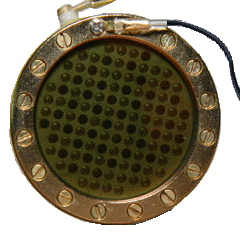
Edac – see Elco connectors.
edge diffraction – the distortion in frequency response and stereo imaging resulting from sound diffracting off the edges of a speaker cabinet. Also called diffraction loss.
edge-fed – see edge-terminated capsule.
edge-terminated capsule – a condenser microphone capsule in which the electrical lead is attached to the edge of the diaphragm, as opposed to a center-terminated capsule. Since the metallized diaphragm touches the edge of the capsule, the outer ring of the backplate must be made of non-conductive material instead of brass. Examples of microphones with edge-terminated capsules are the AKG C12 and the RØDE NT1. Also called edge-fed.
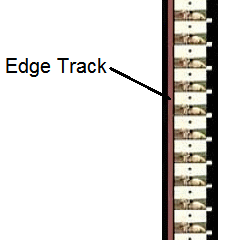
16-mm Film
edge track – (1) In multitrack tape recording, either of the recorded tracks located along the edge of the recording tape. (2) The US standard position of the recorded track on 16-mm magnetic film—the edge opposite the sprocket holes. The first 16-mm film with sound used an optical optical soundtrack. Later a magnetic strip was used on some formulations.
edge yowl – sounds that occur when a loudspeaker resonates, imparting energy back into the cone, creating spurious frequencies that may or may not be harmonically related to the intended note. Also called by slang terms cone cry and ghost notes.
edgy – (1) A descriptive term for a sound that is overly punchy to the point of being uncomfortable. (2) A sound with harmonics that are too strong relative to the fundamentals, resulting in distortion or a raspy sound.
Edison effect – an effect discovered by Thomas Edison in 1883 in which certain materials heated by a filament in a vacuum will emit electrons that are attracted to an electrode with a positive potential with respect to the emitter. This effect became the basis for the invention of the vacuum tube.
Edison plug – see type B plug.
edit – (1) To correct or delete portions of recording tape by splicing the desired parts together using a splicing block and splicing tape. (2) To correct, revise, delete, or improve an audio waveform or MIDI data file in a DAW, much in the same way that you edit text in a word processor. (3) A change or correction made in a recording tape, an audio file, or a MIDI file. (4) A cut down.
edit decision list (EDL) – prior to editing a master recording, video, or film, the various takes are auditioned and a list of the preferred takes and edits to be used from the master recording with SMPTE time codes, along with notes about where to make cuts, edits, fades, dissolves, and other special effects, used primarily with video and post production work. The EDL is usually computer-generated. See also AES31.
edited master – raw audio that has been edited and passed through quality control, but not yet mastered. This term should not be confused with edit master, which is a video master.
editing block – see splicing block.
edit insertion point – (1) A point within a track on a DAW that is clicked for the purpose of making an edit. (2) The point within a track where the start, end, or synchronization point of a clip is to be placed.
edit list – see playlist, definition #3.
edit master – in the video editing process, the videotape that contains the finished, edited program. This term should not be confused with edited master, which is an audio master.
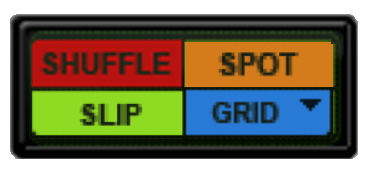
edit mode – (1) A method of operating a tape machine in which the tape lifters are disengaged to provide for easy cueing or editing. Also called cue mode. (2) One of four modes for editing clips in Pro Tools: shuffle mode, slip mode, spot mode, and grid mode.
edit switch – a switch on a tape machine that engages the play mode but not the take-up motor. Recording tape is passed over the playback head and is reproduced, but then spills off the machine to be edited out. This process is called a dump edit. On some machines, the edit switch merely defeats the tape lifters, placing the machine in the edit mode.
EDL – Edit Decision List.
EDM – Electronic Dance Music.
EDT – Early Decay Time.
EDTV – Enhanced-Definition TeleVision or Entended-Definition TeleVision.
E-E – Electronic to Electronic. Using the source (electronic signal) for monitoring rather than the playback head, a term more commonly used in the video industry. Audio technicians usually use the terms monitoring source or monitoring tape. Also called E to E. See also monitor selector.
EES – Early, Early Sound.
EE tape – see extra efficiency tape.
EFC – Energy-Frequency Curve. A plot of energy versus frequency. The same as a frequency response curve.
effect – (1) A hardware or software device used to modify or enhance an audio signal. Effects are generally broken down into four groups: (a) modulation effects, such as chorus, tremolo, flanger, or phaser, (b) time-based effects, such as reverb, delay, or echo, and (c) spectral effects, such as equalization and filters, and (d) dynamic effects, such as compressors, limiters, and gates. (2) The result of using an effects processor to modify or enhance an audio signal.
effective radiated power (ERP) – the amount of power actually radiated by a combination of a power transmitter and antenna. It is equal to the power applied by the transmitter multiplied by the efficiency of the antenna. It takes into consideration transmitter power, transmission line losses, connector insertion losses, and antenna gain, but not the height above average terrain. Also called equivalent radiated power.
effects – (1) Short for sound effects. Often abbreviated SFX or FX. (2) Special effects. Often abbreviated SPFX or FX.
effects blend – a control that adjusts the amount of wet signal from a signal processor that is mixed with the dry signal.
effects bus – a bus on a mixer, console, or DAW that feeds internal plug-ins or external signal processors. Also spelled as the less-preferred effects buss.
effects bypass – see bypass.
effects chain – the series of effects through which an audio signal is passed.
effects cymbal – a cymbal used in a drum kit for a special effect or to creates unusual tonal effects, such as splash cymbals, china cymbals, sizzle cymbals, and many other less common types.
effects loop – (1) A signal path on a mixer, console, or DAW used to add an effect to a signal or a group of signals. A send is used to feed the device and a return is used to bring the signal back from the device, creating the a loop. (2) A signal path out of one device, through an effects unit and back into the first device, such as a guitar or bass amp that has a dedicated insert point for use with an outboard processor.
effects pedal – see pedal.
effects rack – see equipment rack.
effects return – see return.
effects send – see send.
effects processing – see signal processing.
effects processor – see signal processor.
effects track – (1) The audio recording of the mixdown of all the sound effects to be mixed with the dialog and music of a video or film production. (2) A track of recorded effects to be added to another track of a multitrack audio recording.
effects unit – an electronic device used to alter the sound of an audio signal. Although an effects unit can be any type of processor, the term is most often used for (a) an effects processor connected between a guitar and an amplifier that sits on the floor and is turned on and with a foot switch (often called a pedal or stomp box) or (b) a rack-mounted effects hardware unit.
efficiency (η) – the ratio of power output to power input of a device, such as an amplifier or loudspeaker, expressed as a percentage. Note: Power that is lost is converted to heat.
e-field – short for electric field.
EFM – Eight-to-Fourteen Modulation.
EFP – electronic field production.
EFTC – Energy-Frequency-Time Curve.
EFX – abbreviation for effects.
EHF – Extremely High Frequency. The portion of the radio frequency spectrum from about 30 Gz to 300 Gz. See the radio frequency chart.
EIA – Electronic Industries Alliance.
EIAJ – Electronic Industry Association of Japan. A Japanese standard-setting organization founded in 1948, that merged into the JEITA.
EIAJ optical standard – see TOSlink.
EIDE – Enhanced Integrated Drive Electronics. See hard disk drive interface.
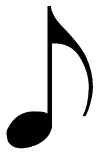
eigentone – the fundamental resonant frequency of a room. From the German “eigen” + “ton,” meaning distinctive tone. Also known as the standing wave frequency. See also room modes.
eighth note – a music note having one-eighth the time value of a whole note. In 4/4 time, the eighth-note is equal to half a beat. Also called a quaver (mainly British).
eighth rest – a rest that has the same length as a eighth note.
eight-to-fourteen modulation (EFM) – a data encoding technique used with compact discs to create a disc that is resistant to handling and storage problems, such as dust and scratches. In this technique each 8-bit block is translated into a corresponding 14-bit codeword.
EIN – Equivalent Input Noise.
EL – ElectroLuminescence.
ELA M250 – short for the Telefunken ELA M 250. See AKG C-12.
ELA M251 – short for the Telefunken ELA M 251. See AKG C-12.

Elco connectors – a multi-pin connector used in audio systems and other devices for connecting multi-pair cables with one connector. Elco is the US manufacture of these connectors, while Edac makes them in Canada. They are available with 20, 38, 56, 90, and 120 pins.
electret – a material that maintains a permanent charge, analogous to a permanent magnet. The name is derived from electricity + magnet.
electret capacitor microphone – see electret condenser microphone.
electret condenser microphone (ECM) – a condenser microphone that uses an electret to supply polarizing voltage instead of phantom power. However, these microphones often still require phantom power to provide power for the on-board preamp. There are three major types of electret microphones: (a) Foil electret, (b) back electret, or (c) front electret. With a foil electret microphone (also called a diaphragm electret, middle electret, or classic electret), a film of electret material is used as the diaphragm itself. This is the most common type of ECM, but it also the lowest quality, because the electret material usually makes a poor diaphragm. With a back electret microphone, the electret film is the back plate of the capsule and the diaphragm is made of a suitable metalized material. With a front electret microphone, there is no back plate. The capacitor is formed by the metalized diaphragm and the inside surface of the capsule, to which the electret film is attached. Also called a prepolarized condenser microphone, electret capacitor microphone, or electret microphone.
electret microphone – see electret condenser microphone.
electric – (1) Pertaining to electricity. (2) Run by, charged with, or producing electricity. (3) Using a microphone to create a audio signal that is electrically-amplified as opposed to using acoustic means. Same as electrical.
electrical – see electric.
electrical charge – see electric charge.
electrical circuit – an electrical network having a closed loop with a return path for the current. See also circuit.
electrical conductivity – see conductivity.
electrical connection – (1) A direct path between two points in a circuit between which a current can flow. It can be a wire, a connector, or other device. Often simply called a connection. (2) A point at which two devices can be connected, usually using cables and connectors.
electrical contact – a piece of electrically conductive metal that allows current to pass from one conductor to another.
electrical contact cleaner – see contact cleaner.
electrical era – the portion of recorded music history from about 1925 to 1947. During this period, records were produced using the electrical recording method. In about 1947, the magnetic tape era began when audio was first recorded to tape before creating a disc. Also called electrical recording era.
electrical force – see electric force.
electrical load – see load, definition #1.
electrical network – is an interconnection of electrical elements such as resistors, inductors, capacitors, voltage sources, current sources and switches. A circuit is an electrical network. An electrical circuit is a network with a closed loop, having a return path for the current. A resistive circuit consists only of resistors, currents, and voltage sources. An electronic circuit is a network that contains active electronic components.
electrical recording – the method of recording introduced in 1925 in which records were recorded by sound being captured by a microphone with the electrically-amplified signal being fed to a stylus that cut grooves directly in a disc. Prior to that time, the acoustic recording process had been used. This period is called the electrical era, which ended in about 1947 with the advent of the magnetic tape era. At that point, recording were made on magnetic tape before being transferred to disc.
electrical recording era – see electrical era.
electrical resistivity – see resistivity.
electrical signal – see electric signal.
electric bass – see bass guitar.
electric charge – the physical property of an object that causes it to experience a force when close to other similarly charged objects. There are two types of electric charges: positive and negative. Sometimes called electrical charge.
electric circuit – see electrical circuit.
electric current – see current.
electric dipole moment – a measure of the separation of positive and negative electrical charges in a system of electric charges. In other words, it is a measure of the overall polarity of the system charges. Electric dipole moment is measured in the SI units of coulomb-meter (Cm).
electric field – a field generated by electrically charged particles and time-varying magnetic fields, defined as the electric force per unit charge. The electric field radiates outward from a positive charge and inward toward a negative charge. Called an e-field for short.
electric force – the force that a charged particle exerts on another charge. Also called an electrical force.

electric guitar – a guitar with a solid body and electromagnetic pickups that convert the vibration of metal strings into signals that can be amplified to drive a loudspeaker. First invented by George Beauchamp in 1931.
electric horses – slang for interference from a cellphone. (This type of interference has a synthetic galloping sound.)
electric instrument – a musical instrument that picks up an acoustically generated sound and uses an amplifier and speaker to enhance the sound, such as electric guitars and bass guitars. By contrast an electronic instrument produces sounds entirely by electronic means, such as electronic keyboards and synthesizers.
electricity – (1) A form of energy resulting from the existence of charged particles (such as electrons or protons), either as static electricity (an accumulation of charge) or dynamic electricity as a current, that occurs naturally (such as lightning) or is produced by a generator. (2) Electric power. (3) The science that deals with the phenomena and laws of electricity.
electric organ – see electronic organ.
electric piano – an electro-mechanical musical instrument that produces sounds mechanically with the sounds being converted to electrical signals with pickups, unlike an electronic piano, or a digital piano, which use electronics to produce their sound.
electric polarization – a slight shift in opposite directions of the positive and negative charge within an insulator or dielectric induced by an external electric field. One of the measures of polarization is electric dipole moment, which equals the distance between the slightly shifted centers of positive and negative charge multiplied by the amount of one of the charges. Polarization (P) is the amount of dipole moment (p) per unit volume (V) of a polarized material, P = p/V.
electric signal – data transmitted by electricity using changes in current, voltage, frequency, phase, or duration. Also called an electrical signal.
electroacoustic guitar – another name for a acoustic-electric guitar. Sometimes spelled electro-acoustic guitar.
electroacoustics – the science dealing with the interaction of electric and acoustic phenomena. Sometimes spelled electro-acoustics.
electroacoustic transducer – a transducer that converts electric signals into acoustic signals. Sometimes spelled electro-acoustic transducer.
electrode – a conductor through which an electric current enters or leaves an object, substance, or region. A positive electrode is called an anode and negative one is a cathode.
electrodynamic microphone – a dynamic microphone that used an electromagnet. The availability of improved, more powerful permanent magnets has made these designs obsolete.
electroforming – a process that creates thin parts through electrodeposition. The part is formed by coating a conductive layer of liquid metal skin onto a base form that is removed after forming, with the metal coating being easily separated from the form. This is the process used in vinyl mastering. It is the opposite of electroplating.
electroluminescence (EL) – a phenomenon in which a material (usually a semiconductor) emits light in response to the passage of an electric current or in the presence of a strong electric field.
electroluminescent panel (ELP) – a plastic sheet containing a phosphor layer that uses electroluminescence to light up when the proper voltage is applied.
electrolyte – a liquid that conducts electrical current. Chemical additives have to be added to water to make it conductive. Batteries and electrolytic capacitors often contain electrolytes.
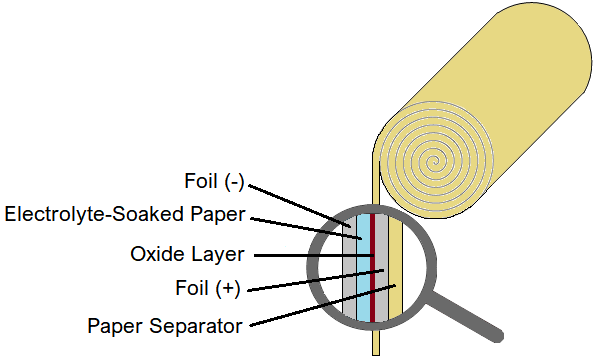
electrolytic capacitor – a type of capacitor consisting of two metallic foils (usually aluminum or tantalum) and a paper spacer soaked in electrolyte. One of the foils has an oxide layer, which acts as the anode, while the uncoated foil acts as a cathode. The foils and electrolyte-soaked paper are rolled up and placed into a cylindrical enclosure and connected to the circuit using pins. Electrolytic capacitors can achieve much larger capacitance than other capacitor types. The disadvantages are large leakage currents, value tolerances, equivalent series resistance, and a limited lifetime. See also ceramic capacitor and film capacitor.
electromagnet – a core of magnetic material, such as iron, surrounded by a coil of wire through which an electric current passes creating a magnetic field. The magnetic field goes away when the current is turned off, unlike a permanent magnet which is always magnetic without external forces.
electromagnetic – pertaining to the interrelation of electric currents or fields and magnetic fields.
electromagnetic energy – a form of energy that is reflected or emitted from objects in the form of electromagnetic radiation that can travel through space, such as radio waves, visible light, X-rays, and microwaves. Also called radiant energy.
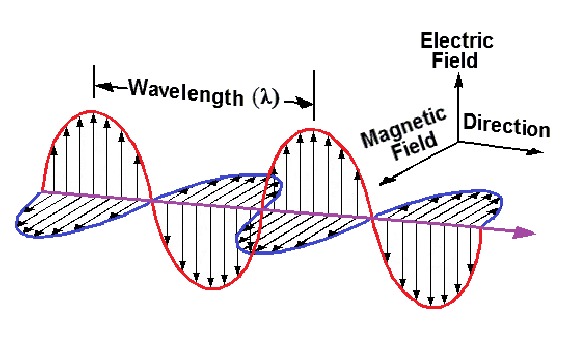
electromagnetic field (EMF) – a force field consisting of both electric and magnetic components, resulting from the motion of an electric charge and containing electromagnetic energy.
electromagnetic induction – see induction.
electromagnetic interference (EMI) – interference in audio equipment produced by the equipment or cables picking up stray electromagnetic fields, which produces hum, static, or buzzes. Such interference can be caused by fluorescent lights, power lines, computers, computer monitors, light dimmers, and AM, FM, and TV transmitters. Also called radio-frequency interference (RFI) when in the source is within the radio frequencies.
electromagnetic pickup – see magnetic pickup.
electromagnetic radiation – energy in the form of electromagnetic waves.
electromagnetic spectrum – the entire range of frequencies of electromagnetic radiation extending the lowest frequency radio waves to the highest frequency gamma rays, which includes visible light. See chart at radio frequency spectrum.
electromagnetic unit (emu) – a unit in the CGS system used to measure electric field and magnetic field strengths, electric current strengths, and other quantities associated with electromagnetism. It is equal to one erg/oersted and 103 emu equals 1 Am2.
electromagnetic wave – waves of energy associated with electric and magnetic fields resulting from the acceleration or oscillation of an electric charge.
electromagnetism – (1) The interaction of electric currents or fields and magnetic fields. (2) The study of the interaction of electric currents or fields and magnetic fields.
electromechanical – relating to a device, process, or system that converts electrical energy to mechanical energy or vice versa or that combines electrical and mechanical processes. Examples include solenoids, potentiometers, relays, and piezoelectric devices that are used to control, create, or adjust electric signals. Sometimes spelled electro-mechanical.
electromotive force (EMF) – the voltage developed by any source of electrical energy such as a battery or dynamo. It is represented by the Greek letter epsilon (ε).
electronic – (1) Pertaining to or operating using a circuit with many small components, especially microchips and transistors, that control an electric current. (2) Pertaining to instruments that use electric or electronic means to produce or modify the sound. (3) Pertaining to or controlled by computers or computerized systems.
electronic circuit – an assembly or electrical network of components, such as transistors, vacuum tubes, resistors, and capacitors, designed to perform a particular function. See also circuit.
electronic component – any basic discrete device or physical entity used to affect electric currents, voltages, and fields, such as resistors, capacitors, vacuum tubes, and transformers. These components are used to create electronic circuits with a particular function, such as an amplifier, radio receiver, or oscillator.
Electronic Components Association (ECA) – a trade association of manufacturers and suppliers of passive and active electronic components, component arrays and assemblies, and commercial and industrial electronic equipment and supplies. It was formerly a division of the Electronic Industries Alliance (EIA).
electronic crossover – see crossover.
electronic dance music (EDM) – a group of highly percussive electronic music genres used primarily in dance-based venues, such as nightclubs. It includes trance, house, techno, breakbeat, and many more styles. Also called dance music and club music.
electronic field production (EFP) – television industry video production that takes place in the field, not in a formal television studio. EFP includes productions, such as sporting events, concerts, nature documentaries, and conventions like the Democratic or Republican National Conventions. EFP that focuses on news reporting is often called electronic news gathering (ENG). EFP crews can range from a single camera to an entire mobile production truck.
Electronic Industries Alliance (EIA) – a former trade association of electronic manufacturers that set standards for the voluntary use by manufacturers, conducted educational programs, and lobbied in Washington. It was founded in 1924 as the Associated Radio Manufacturers (ARM), but later that year changed its name to the Radio Manufacturers Association (RMA). In 1950 it became the Radio Television Manufacturers Association (RTMA), and then the Radio Electronics Television Manufacturers (RETMA) in 1953. In 1957 it was renamed the Electronics Industries Association (EIA) finally becoming the Electronics Industries Alliance (EIA) in 1997. The EIA ceased operations in 2011, dividing its activities into its constituent divisions: Electronic Componets Association (ECA), Joint Electron Devices Engineering Council (JEDEC), Government Electronics and Information Technology Association (GEIA), Telecommunications Industry Association (TIA), and Consumer Electronics Association (CEA).
electronic instrument – a musical instrument that produces sounds entirely by electronic means, such as electronic keyboards and synthesizers. By contrast an electric instrument pickups an acoustically generated sound and uses an amplifier and speaker to enhance the sound, such as electric guitars and bass guitars.
electronic keyboard – an electronic or digital keyboard instrument, which has white and black piano-style keys, a sound generator or a synthesizer capable of accepting MIDI commands and producing sounds, control keys to select tones, such as piano, organ, flute, and drum kit, effects, such as reverb, echo, or sustain, and an amplifier and a speaker. Also called a digital keyboard, portable keyboard, or home keyboard.
electronic music – music created using electronic musical instruments and electronic music technology, such as synthesizers, theremins, and computers. A distinction is usually made between electronic music and music produced using electromechanical means, such as the electric guitar or Hammond organ.
electronic musician – a musician who composes and/or performs electronic music.
electronic music distribution (EMD) – distributing digital music files (usually compressed using MP3, AAC, AC-3, or other codecs) from a server on the internet to a customer via download.
electronic news gathering (ENG) reporting the news using electronic audio and video devices, originally small, mobile devices such as small video cameras used to record the scene at a news event. The term came to be used by the broadcast news industry in the 1980s when such devices first started being used. Electronic news gathering now includes everything from an individual reporter with a small audio recorder or video camera to a large crew using a satellite truck. The FCC has reserved ten ENG video channels in each broadcast market for satellite trucks to send ENG feeds back to the broadcast station. Today many electronic journalists use smart phones and small audio recorders to record news events, which can be uploaded directly. ENG is a form of electronic field production (EFP).
electronic organ – a musical instrument that simulates the sound of a pipe organ and other instruments using a keyboard, tonewheels, electronic circuits, synthesizer techniques, and/or digital methods.
electronic piano – an electronic musical instrument that simulates the timbre of an acoustic piano by synthesizing the tones. It is sometimes confused with, but not the same as a digital piano, which simulates the sound of a piano using digital samples of real pianos.
electronic pickup – see magnetic pickup.
electronics – (1) The science that deals with the behavior of electrons in vacuums, gases, semiconductors, and conductors. (2) The technology concerned with the development, behavior, and applications of electronic devices and circuits. (3) The circuits, wiring, and components in a device or piece of equipment.
electronic signal – an electrical signal in which current, voltage, or other parameter is varied in such a way to convey information.
electronic software distribution (ESD) – see digital distribution.
electronic stereo – see simulated stereo.

Electronic Tuner
electronic tuner – an electronic device that analyzes the frequency of the note being played by an instrument and indicates whether that frequency is sharp or flat as compared to a reference pitch, usually A440, although most electronic tuners can be set to other reference pitches. The player can then tune his or her instrument to the correct pitch.
electron tube – see vacuum tube.
electro-optical circuit – a circuit consisting of strips or layers of light conducting material on a substrate onto which light emitting and light sensitive electrical components are attached, designed to perform a specific function. They have no moving parts and are used in computers, compressors, limiters, gain controllers, potentiometers, and many other applications.
electro-optics – a technology involving components, devices, and systems which operate by modification of the optical properties of a material by an electric field. Sometimes spelled electrooptics. It should not be confused with optoelectronics. See also the Kerr effect.
electrophone – a classifications for musical instruments that produce sound primarily by electrical means according to the Hornbostel-Sachs system of musical instrument classification. The term does not apply to instruments where electricity is used only to amplify a sound. So an electric guitar would be classified as a chordophone. The other four classifications are idiophone, membranophone, chordophone, and aerophone.
electroplating – a process that uses an electrical current to reduce metal ions dissolved in a liquid solution causing them to form a tight bond that plates an electrode. This is the opposite of electroforming.
electrostatic charge – the buildup of charge on the surface of an insulated body, which establishes an adjacent electrostatic field.
electrostatic discharge (ESD) – the release of static electricity between two charged objects when they come to within close contact with one another. Some electronic devices, such as some integrated circuits and transistors, can be damaged by accidental electrostatic discharge. Precautions must be taken to protect such devices by storing them in a conductive foam and by grounding yourself or standing on special mats before handling these devices.
electrostatic field – the force field between two conductors charged with static electricity.
electrostatic force – the interaction between electrically charged particles.
electrostatic headphones – headphones that operate by placing a static (non-moving) electric charge on a very thin film that floats between two perforated metal plates. When voltage from an audio signal is applied across the plates, the charge attracts and repulses the film moving the air around it creating sound. Because the film weighs less than the air surrounding it, it produces no resonances or energy buildup that can lead to the coloration produced by dynamic headphones. It is similar in operation to a condenser microphone. Electrostatic headphones are usually more expensive than dynamic headphones and require a special amplifier that produces output in the range 100 to 1000 volts. See also planar magnetic headphones.
electrostatic interference – the undesired presence of an electrostatic field causing a hum or other noises in an audio signal.
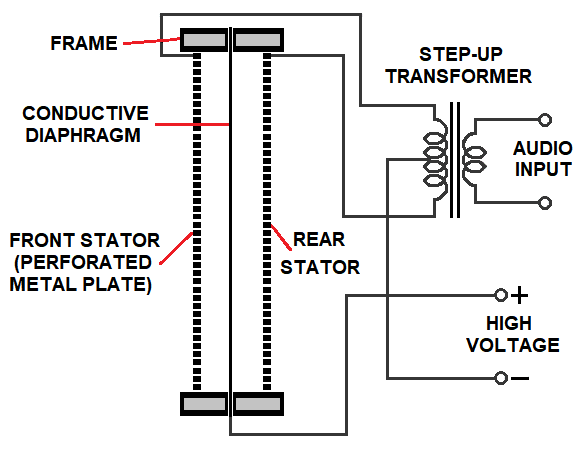
electrostatic loudspeaker (ESL) – a type of flat-panel loudspeaker that uses a high-voltage electric field, rather than a magnetic field, to drive a thin, statically-charged membrane that is stretched between two static elements called stators. They are driven over the entire membrane surface rather than from a small voice coil resulting in a more linear motion with less distortion than conventional dynamic loudspeakers. Because they also have a relatively narrow radiation pattern, they can be used for precise sound-field positioning, but that also means that the optimum listening position is rather small. They are fairly inefficient speakers. To improve efficiency higher voltages are sometimes used, which increases the tendency for electrical arcing. The membrane also has a tendency to attract dust particles. Because of the membrane, electrostatic speaker are not well suited for use in enclosures. To obtain a full response, electrostatic loudspeakers have to be very large. To reduce the size, they are sometimes used as high-frequency drivers in combination with conventional dynamic drivers that handle the bass frequencies. Electrostatics are typically driven using a step-up transformer to increase the voltage. The transformer also increases the capacitive load so that the effective impedance varies widely with frequency.
electrostatic microphone – see condenser microphone.
electrostatic tweeter – see tweeter.
Electro-Voice (EV) – a manufacturer of audio equipment founded in 1927 in South Bend, Indiana. It manufactures products for the pro audio and consumer market, including microphones, amplifiers, and loudspeakers. It became a division of Telex in 1998, which was subsequently acquired by the Bosch Group in 2006.
Electro-Voice 642 Cardiline – a shotgun microphone introduced by EV in 1961, the first shotgun microphone ever produced. In 1963, it won an Academy Award for revolutionizing motion picture sound, the first audio product to win the award.
Electro-Voice RE20 – an industry-standard large-diaphragm cardioid dynamic microphone, used worldwide on applications ranging from broadcasting and voice overs to vocals and kick drum. It has been called “the everything” microphone. It uses EV's patented Variable D design to control the proximity effect. The RE20 was also marketed as the PL-20, a rebranding for some special models. Sometimes shown as EV RE-20.
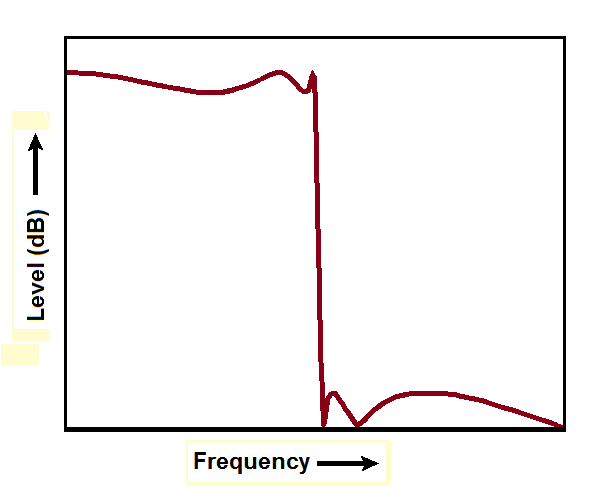
element – (1) A constituent part of a sound characteristic. For example, bass, midrange, and high end are elements of frequency response, while attack and decay are elements of an ADSR envelope. (2) Short for generating element. See capsule.
ELF – Extremely Low Frequency. The portion of the radio frequency spectrum from about 3 Hz to 30 Hz. See the radio frequency chart.
elliptical equalizer – an equalizer that moves all frequencies below a particular frequency (typically 250, 150, 70, or 30 Hz) in the left and right filterchannels of a stereo signal to the center. This process is used in the vinyl mastering process to prevent excessive lateral movement of the cutting stylus due to excessive low-frequency energy in one channel.
elliptical filter – see elliptic filter.

elliptical stylus – a stylus with a conical tip that has two cuts made in it to make a longer vertical contact with the groove and a narrower front-to-back contact. An elliptical stylus tracks the groove more precisely than a conical stylus, which improves frequency response and phase response and lowers distortion, especially in the inner grooves of the record.
elliptic filter – a filter with ripples in both the passband and the stopband (equiripple). The amount of ripple in each band can be independently adjustable. Elliptic filters have the fastest roll-off slope in the transition band of any filter. As the ripple in the stopband approaches zero, the filter becomes a Type I Chebyshev filter. As the ripple in the passband approaches zero, the filter becomes a Type II Chebyshev filter. As the ripple in both bands approach zero, the filter becomes a Butterworth filter. Also called a elliptical filter, Cauer filter, after Wilhelm Cauer, or a Zolotarev filter, after Yegor Zolotarev.
ELP – ElectroLuminescent Panel.
Emagic – a music software and hardware company headquartered in Rellingen, Germany, with a satellite office in Grass Valley, CA. Emagic began business in the 1980s as C-Lab. Emagic was acquired by Apple in 2002.
embellishing tone – see nonchord tone.
EMC Directive – ElectroMagnetic Compatibility Directive. A directive issued by the European Commission that requires products within the European Union (EU) to not emit undesired electromagnetic interference and to be immune to a normal level of interference.
emcee – Master of Ceremonies, from the abbreviation MC.
EMD – Electronic Music Distribution.
EMF – ElectroMotive Force or ElectroMagnetic Field.
EMI – ElectroMagnetic Interference.
EMI Group Limited – a British multinational music recording and publishing company, and manufacturer of electronics devices and systems, headquartered in London, England, until it was broken up in 2012. Its record labels included EMI Records, Parlophone and Capitol Records. Its music division was sold to Vivendi's Universal Music Group, and the publishing business was sold to a Sony/ATV Music Publishing. EMI stood for Electric and Musical Industries, which was formed by the merger of The Gramophone Company and Columbia Graphophone Company in 1931.
emission – the radiation of an radio frequency (RF) signal, whether intentional or not.
emitter follower – a transistor with an output voltage that is less than the input voltage, but with high input resistance and low output resistance, that operates somewhat similarly to a cathode follower.
emphasis – a process in which an equalization curve is applied during recording or broadcasting (called pre-emphasis) with a subsequent application of a complementary curve during playback or reception (de-emphasis), in order to reduce noise or correct other deficiencies. See RIAA curve, Academy curve, X curve, NAB curve, and CCIR curve.
EMT – Elektro-Mess-Technik. A manufacturer of phonograph turntables and professional audio equipment. It was founded by Wilhelm Franz as Elektromesstechnik Wilhelm Franz K.G. in Berlin in 1938. It is probably best known in profession audio for the introduction of the EMT 140 plate reverb. In 1989, EMT was bought by Barco of Belgium becoming Barco-EMT. Their professional audio products were gradually phased out. In 2003, Barco sold the company to Walter Derrer, and it began operating as EMT Studiotechnik GmbH.
EMT 140 – a plate reverb introduced by EMT in 1957. A breakthrough in audio technology, it quickly rose in popularity, providing a lush and smooth substitute for spring reverb systems of the day. Although it weighed about 600 pound, the EMT 140 occupied much less space than an echo chamber. Universal Audio now produces a plug-in modeled after the legendary EMT 140.
emu – ElectroMagnetic Unit.
E-mu SP-1200 – a drum machine and sampler released in 1987, produced by E-mu Systems, Inc. It achieved legendary status among rap and hip-hop artists during the 1980s and 1990s. Although it was intended to be used as both a drum machine and sequencer, its primary use became that of a sampler. An improvement of the SP-12, the SP-1200 omitted the preset drum sounds of the SP-12, which left room for up to 32 user samples of custom sampled and edited drum sounds. It could be used to create most of a song within one piece of portable gear, a first for the industry, which reduced studio costs and increased creative control for hip-hop artists.
E-MU Systems – a manufacturer of synthesizers, audio interfaces, and MIDI devices. Founded in 1971 as E-mu Systems, Inc., it was a pioneer in samplers, drum machines, and low-cost digital sampling music workstations. In 1993, it was acquired by Creative Technology, Ltd., who in 1998 acquired Ensoniq, another synthesizer and sampler manufacturer. It then merged E-Mu and Ensoniq.
emulated output – an output from a preamp or other device that has signal processing to emulate the sound of miking a guitar cabinet, commonly used to feed directly into a mixer, audio interface, or live sound system. See also amplifier modeler.
emulation – a signal processor that emulates the sound of miking a guitar cabinet or of piece of hardware, such as an equalizer. See also amplifier modeler.
emulator – see amplifier modeler.
enclosure – see speaker enclosure.
enable – the function in some DAWs of turning on a track or plug-in, so that it is using CPU or DSP resources. The opposite of disable. Depending on the DAW this process may be referred to as activate, unmute track with CPU-saving preference selected, or unarchive.
encode – (1) To convert data, information, or instruction into a particular form, especially a form that can be read by a computer. (2) To convert a signal into a form suitable for transmission. (3) To apply a noise reduction system, such as Dolby, to a recording tape. (4) To change the format of a file or to compress the file into a smaller size. Also called to code. (5) To impart additional information onto an audio signal, such as spatial information. (6) To change the format of a file or to compress the file into a smaller size. Also called to code. The opposite of decode.
encoded tape – a recording tape to which a noise reduction system has been applied, such as Dolby. It should be decoded upon playback.

encoder – (1) A device or software application that converts the digital format of a file or data into another format. (2) A physical knob or control on a hardware or software device that sends out digital control signals as assigned by software to control various parameters, such as pan on a DAW or filters on a synthesizer. Also called a soft knob.
enclosure – see speaker enclosure.
encryption – the process of converting digital data from an open form that anyone can access to a closed form requiring a secret key to access or to convert it back into the open form.
end-address – a microphone which picks up sound from the end, rather than the side. Also called end-fire or top-address. See also side-address.
end-fire – see end-address.
end groove area – see run-out groove area.
endless encoder – a rotary knob used to digitally control a parameter in a software or hardware device having no stopping point, but continues to turn until the user stops moving it. An endless encoder can support a very wide range of parameter values or very fine control, as there is no physical limitation to the range of the knob rotation. See also encoder.

(EFTC)
endless loop – a length of magnetic recording tape in which the end is attached to the beginning so that it play continuously. Endless loops are used on some devices to produce effects such as echo. They are also used in tape cartridges such as 4-track, 8-track, and Fidelipac.
energy – the ability of a system to perform work. The SI unit for energy is the joule, the energy required to move an object 1 meter against a force of 1 newton. See also power.
energy-frequency-time curve (EFTC) – a three-dimensional graphical plot of acoustic response with frequency, energy, and time on the three axes. Sometimes called a waterfall curve or waterfall plot. Compare with energy-time curve (ETC).
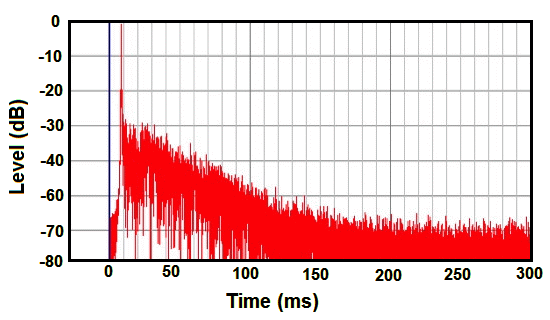
energy-time curve (ETC) – a two-dimensional plot of energy versus time showing the energy relative to the level of the energy in the first peak following an impulse response (IR). The first spike in the ETC is the direct sound usually shown at a level of 0 dB and a time of 0 ms, followed by spikes which are reflections from various surfaces in the room. The plot is similar to a reverb time contour, except it shows spikes from individual reflections, which can aid in determining from where reflections are coming. Compare with energy-frequency-time curve (EFTC).
ENG – Electronic News Gathering.

engineer – (1) To make a recording or to manage a live sound mix. (2) Short for audio engineer or recording engineer, or broadcast engineer.
English flageolet – see penny whistle.
English horn – an alto woodwind instrument similar to the oboe, having a bulbous bell and being pitched a fifth lower than the oboe.
Enhanced AAC+ – see High Efficiency Advanced Audio Encoding.
Enhanced AC3 – see Dolby Digital Plus.
Enhanced CD (E-CD) – a certification mark of the RIAA for several formats that combine audio with computer data that can be used in compact disc and CD-ROM players. These multi-session formats include mixed mode CD (Yellow Book CD-ROM and Red Book CD-DA), CD-i, CD-i Ready, and CD-Extra and CD-Plus (Blue Book). Enhanced CDs can take advantage of unused space on music CDs to add extra information such as video clips, artist profiles, lyrics, interviews, animation, and promotional material. Also called Enhanced Music CD.
enhanced-definition television (EDTV) – a designation for digital television (DTV) formats and devices as specified by the Consumer Electronics Association (CEA) for formats that deliver higher-quality images than that of standard-definition television (SDTV), but not as good as high-definition television (HDTV). Also called extended-definition television.
enhanced harmonic content – see harmonic synthesis.
enhancer – see exciter.
enhanced stereo – see simulated stereo.
enharmonic – musical notes that are the same pitch, but are written with different notations, such as B and C♭ or C♯ and D♭. Contrast with inharmonic.
ENR – Excess Noise Ratio.
ensemble – (1) A group of musicians, singers, dancers, or actors who perform together. Sometimes called a band, music group, or combo. (2) A work for two or more vocalists or instrumentalists. (3) The performance of such a work.
entropy coding – a type of lossless coding used to compress digital data by representing frequently occurring patterns with a few bits and rarely occurring patterns with many bits.

envelope – the variations that a sound exhibits over time—how it starts, continues, and disappears. Essentially it is the plot of amplitude vs time for a musical sound. This is defined by ADSR — attack, decay, sustain, release or AHDSFR. In addition, other sonic distinctions such as transients, pitch, timbre, and harmonic content may be considered part of the overall envelope making up a sound.
envelope control – in a synthesizer pitch and volume controlled by voltage to create a distinctive contour (envelope).
envelope follower – a device that converts the envelope of a audio signal into a control voltage that can be used to control another parameter.
envelope generator – a circuit that generates a control signal to represent the envelope of the sound to be created, which is used to control the level of an oscillator, filter, modulator, or other sound source. The most common example is the ADSR generator. Also called a contour generator.
envelopment – the degree to which an audio signal is perceived as being all around the listener as in a surround sound or 3-D environment. Full envelopment means sound is coming toward the listener in every direction.
environmental sounds – see background noise.
EP – Extended Play. A musical recording that contains more music than a single, but not as much as an album or LP. Originally an EP was a vinyl record typically containing four songs, but the term is now used for compact discs usually having four to six songs, as well as downloads having fewer than a full album of music.
Epson – Seiko Epson Corporation (Seiko Epuson Kabushiki-gaisha). A Japanese electronics company, headquartered in Suwa, Nagano, Japan, that manufacturers computer printers, imaging equipment, multimedia and home theatre projectors, and many other electronic devices. It is a division of the Seiko Group, known for making Seiko timepieces.
EQ – EQualize, EQualizer, or EQualization.
EQ band – a range of frequencies within the audio spectrum upon which an equalizer makes amplitude adjustments.
EQ creep – a common problem when mixing where changing one band of EQ creates the need or desire to change another band and then another until the mix dissolves into a hopeless mess.
EQ curve – see equalization curve.
equalization – the adjustment of specific frequency bands to alter the tonal balance or to remove unwanted frequencies of audio. Often abbreviated as EQ. British spelling equalisation.
equalization curve – a standardized equalization applied to an audio signal, used during the process of emphasis. The curve is applied during pre-emphasis and a complementary curve is applied during de-emphasis. There are a number of such curves designed for various purposes, such as the RIAA curve, the Academy curve, the X curve, the NAB curve, and the CCIR curve.
equalize – to use an equalizer to adjusts the tonal balance of an audio signal. Often abbreviated as EQ. Brtish spelling is equalise.

equalizer – a device that divides an audio signal into various frequency bands and adjusts the tonal balance of each band by altering its relative amplitude. Equalizers come in two varieties, graphic and parametric. Equalizers consist of one or more filters that can be adjusted to boost or cut various frequency ranges. Brtish spelling is equaliser.
equal level curves – a method of mapping loudspeaker output patterns showing lines where the sound pressure levels are the same. Also called isobaric contours.
equal-loudness contours – see equal loudness curves.
equal loudness curves – a plot of sound pressure levels in dB(SPL) over the audio spectrum that an average listener without hearing impairment perceives as being the same loudness when presented with pure steady tones. Such curves were developed by Fletcher and Munson and Robinson and Dadson. Also called equal-loudness contours.
equal temperament – a tuning system or temperament in which an octave is divided into twelve equal parts (semitones). Each semitone is equal to 12√ 2 = 21/12 = 1.059463. This is the system used in most western music today. See table below. Also called even temperament or equal-tempered scale. Abbreviated variously as 12-TET, 12TET, 12tET, 12tet, 12-ET, 12ET, or 12et. See also intonation, Pythagorean tuning, just intonation, mean-tone temperament, and harmonic series tuning.
| Musical Interval | Frequency Ratio to Tonic | Interval Step |
|---|---|---|
| Tonic | 1:1 | — |
| 2nd | 1.1225:1 | 1.1225 |
| 3rd | 1.2600:1 | 1.1225 |
| 4th | 1.3350:1 | 1.0595 |
| 5th | 1.4986:1 | 1.1225 |
| 6th | 1.6823:1 | 1.1225 |
| 7th | 1.8885:1 | 1.1225 |
| Octave | 2:1 | 1.0595 |
equidistant speaker layout – see Dolby Atmos speaker layout.
equipment grounding conductor – a conductor used to connect non-current-carrying metal parts of equipment and enclosures to the system grounded conductor or grounding rod at the service entrance of a facility. Outside the US, this is called a protective earth conductor (PEC).
equipment noise – the noise produced by all the components of a tape recording system, excluding tape noise. See also system noise.
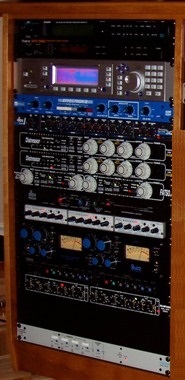
equipment rack – a cabinet that contains rails with screw holes at specified spacing to house electronic equipment, such as preamps, compressors, and equalizers. Equipment racks are measured in units called U. Also called an audio rack, effects rack, or simply rack for short.
equiripple – see elliptic filter.
equivalent acoustic distance (EAD) – in sound reinforcement the distance from a loudspeaker that would be equivalent to the sound heard without sound reinforcement.
equivalent continuous noise level – see equivalent sound level.
equivalent input noise – an indication of the amount of noise that an amplifier or preamplifier will add to the input signal.
equivalent noise level – a specification that indicates the self noise of a microphone. It is the sound pressure level that creates the same voltage as the self noise produced by the microphone. A low noise level is desirable when working with low level sounds, so the sound will not be covered up by the microphone noise. Equivalent noise levels are typically measured using the dB(A) scale, which weights the sound level according to the ear's sensitivity. Good results with this scale are considered to be below 15 dB(A).
equivalent sound level (Leq) – the sound pressure levels (SPL) of a continuous signal over a given time interval that would produce the same energy as the fluctuating sound level that you are measuring. Sometimes called equivalent continuous noise level.
e-radio – see internet radio.
erase – to remove an audio signal from magnetic recording tape to make it ready for re-recording. Tape can be erased in two ways: (a) ac erasure, in which an erase frequency tone randomizes the magnetization of the magnetic particles, or (b) dc erasure, in which the tape is saturated by applying a magnetic field primarily in one direction. A tape can be erased by passing the tape over an erase head or by placing the whole reel of tape in a decreasing magnetic field using a bulk eraser.
erase frequency – the frequency of the tone (usually between 150 kHz and 300 kHz) sent through an erase head to erase the signal on a recording tape.
erase frequency tone – the high-level signal at the erase-frequency sent through an erase head to randomize the orientation of the particles in the magnetic coating of a recording tape to remove (erase) the signal. Also called an erase tone.
erase head – the head on a tape recorder located just before the record head that applies an erase frequency tone, that removes the signal from the recording tape, usually before recording a new signal, but sometimes to simply remove the signal. See tape machine for diagram.
erase oscillator – a very high-frequency oscillator built into a tape recorder to supply the current to the erase head. In most machines, the same oscillator supplies the bias and erase frequency tone.
erase tone – see erase frequency tone.
erg – the CGS unit of work or energy, equal to the work done by a force of one dyne moving a distance of one centimeter in the direction of the force. One erg is equal to 10-7 joules.
ERG – Electric Rhythm Guitar.
ERL – Echo Return Loss.
ERN – Electronic Eelease Notification. See DDEX.
ERP – Effective Radiated Power or Equivalent Radiated Power.
error concealment – an error protection technique that replaces missing information in a digital audio signal using an algorithm that estimates what the probable data should be. The data may not be identical to the original, but if done well should go unnoticed.
error correction – an error protection technique that corrects data errors by using redundant data within a data block so that the corrected data is identical to the original. Sometimes called error recovery.
error correction code (ECC) – an algorithm for correcting errors in a digital audio file. See error protection.
error detection – an error protection technique that determines that data has been lost in a digital audio signal.
error protection – all of the techniques and procedures that together handle error detection, error concealment, and error correction functions for a digital audio file.
error recovery – see error correction.
ESD – (1) ElectroStatic Discharge. (2) Electronic Software Distribution. See digital distribution
ESDI – Enhanced Small Disk Interface. See hard disk drive interface.
ESS – Early Sound Scattering.
essence – the audio data portion of a digital audio file or stream, excluding metadata and time codes.
ESU – Equipment Set-Up. An acronym used primarily in the television industry for assembling and putting up the required gear, such as cameras, tripods, and microphones, during preproduction of a program in the studio or on location.
E-taper – see taper.
ETC – Energy-Time Curve.
etched – a descriptive term for a sound that is clear but very close to being edgy, with emphasized extreme high frequencies.
Ethernet – a type of local area network developed by Xerox in the 1970s that provide a method for computers, printers, and other devices to be connected together in such a way that they can communicate with one another.
Ethernet header – a data field included at the beginning of an Ethernet packet, which converts it into a frame for transmission. Each frame begins with an Ethernet header that has as its first two fields the destination and source MAC addresses. Sometimes called a MAC (media access control) header.
EtherSound – an Audio over Ethernet (AoE) system developed and licensed by Digigram.
E to E – Electronic to Electronic. See E-E.
EUCON – an open communications protocol that provides a high-speed Ethernet connection between a control surface and a digital audio workstation (DAW). It carries display data and conveys information about the positions of faders, knobs, and buttons on the control surface. EUCON was developed by Euphonix, which was acquired by Avid in 2010. It is supported by a wide variety of applications, including Pro Tools, Media Composer , Logic Pro, Cubase, Nuendo, Premiere, Audition, and others. Other protocols, such as MCU and HUI, use MIDI rather than Ethernet. Sometimes shown as EuCon.
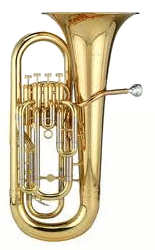
EULA – End User License Agreement. The terms and conditions associated with purchased software.
Euler's number (e) – a mathematical constant named for Leonhard Euler, used as the base of the natural logarithm. It is equal to approximately 2.71828... It is the limit of (1 + 1/n)n as n approaches infinity, an expression that come from the study of compound interest. It is also the sum of the infinite series 1 + 1/1 + 1/(1*2) + 1/(1*2*3) ... It is used in many science and engineering applications.
euphonic – having a sonically pleasant or agreeable sound, especially when the sound is inaccurate or colored.
euphonium – a conical-bore, baritone-voiced brass musical instrument smaller than a tuba and having a somewhat higher pitch and a mellower sound.
Euphonix – a professional audio company founded in the late 1980s and located in Mountain View, California. Euphonix produces consoles, mixers, and other audio equipment for the recording studio and broadcast industry. It was acquired by Avid in 2010.

Euroblock – a type of terminal block connector with interlocking male and female connectors, typically used for the same type of signals as are used with balanced XLR or TRS connectors, found primarily in pro audio devices. The name is short for European style terminal block.
Europlug – a two-prong power plug used for domestic ac power in many European countries, except in the UK, Cyprus, Gibraltar, Ireland, and Malta. It was first specified in 1963 in Standard Sheet XVI of CEE Publication 7, and, therefore, is often referred to as a CEE 7/16 plug. It is also called a C5 plug.
Eurorack – a 3U high, 19-inch wide powered equipment rack designed for use with modular synthesizers available from a range of manufacturers, somewhat similar to but somewhat different from the 500 Series format.
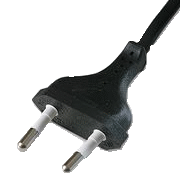
EUT – Equipment Under Test. See device under test.
EV – common abbreviation of Electro-Voice. Sometimes written as E-V.
evacuation tip – a pointed glass tip extending from the top or bottom of a vacuum tube, the remnants of the stem through which air is removed during manufacturing. When it is on the bottom, it is usually hidden inside the tube spigot.
even-order harmonic distortion – see odd-order harmonic distortion.
event – (1) A single unit of MIDI data, such as a note being turned on or off, a program change, controller information, etc. (2) A defined portion of an audio file in some DAWs. Other DAWs refer to this as a region, segment, zone, clip, or sound bite.
event list – an alphanumerical list of MIDI messages and events, including start and end points, length, channel, and values, which can be edited as needed. Besides the event list, messages can be edited by graphic editing and in some MIDIsequencers by using a score editor.
event editing – see step input.
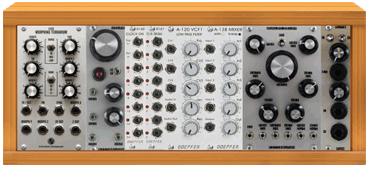
even temperament – see equal temperament.
excess noise ratio (ENR) – a normalized measure of how much the noise source is above thermal noise.
exciter – a signal processor used to add back some of the high-frequency content sometimes lost in audio production. Techniques used include dynamic equalization with harmonic synthesis, phase manipulation, and other algorithms. Also called an aural exciter or enhancer.
excursion – the distance a speaker cone travels back and forth (in and out) from its nominal resting position.
expand – to increase the dynamic range of an audio signal.
expander – (1) A signal processor or electronic circuit that increases the dynamic range of an audio signal when it goes above or below a threshold. (See expansion.) (2) The reception portion of a compander.
expansion – (1) The increase in dynamic range of an audio signal caused by an expander when the signal crosses a threshold. There are two basic types of expansion: (a) downward expansion and (b) upward expansion (sometimes called dynamic expansion). Downward expansion is the most common type of expansion and is used in the typical expander processor. Downward expansion decreases the level of a signal when the signal goes below the expansion threshold. The amount of level reduction is determined by the expansion ratio. It is usually used to improve the signal-to-noise ratio of a recording. Upward expansion boosts the signal by the expansion ratio when the signal goes above the threshold. This is basically the opposite of dynamic range compression. It is the method used to restore the original dynamic range of an audio signal that was compressed during transmission or recording in the process of companding. In the extreme a downward expander becomes a noise gate, in which lower signal levels are reduced significantly or completely eliminated. A ratio of 10:1 or higher can be considered a noise gate. Also called audio expansion.
expansion ratio – in downward expansion, the ratio of change in input level to the change in output level that occurs when the signal goes below the expansion threshold. For example, with a downward expansion ratio of 3:1, if the level drops 1 dB below the threshold, the expander will reduce it to 3 dB below the threshold. For an upward expansion ratio of 3:1, the output level is increased by 3 dB for every 1 dB of change in input level above the threshold. Also called expansion slope or slope for short.
expansion slope – see expansion ratio.
export – to save audio files or MIDI files from a DAW session to a hard drive or other memory device. Most DAWs allow one or several tracks or the mixed down stereo master track to be saved. See also import.
ext clock – short for external clock.
extension – see file extension.
extension block – see power strip.
external clock – (1) A master clock that is separate and independent of the clocks in other devices that sends a timing signal to all slaves to maintain synchronization among the various devices. (2) A clock signal received from another device. Often abbreviated as ext clock.
extra efficiency tape – a formulation of high performance reel-to-reel recording tape introduced in the 1980s, that used an equalization of 35 μsec rather than normal 50. It is now obsolete. Also called EE tape.
extreme high end – audio frequencies of 10 kHz to 20 kHz.
Eyring formula – a formula developed by Norris Eyring for estimating reverberation times. The formula is RT60 = k × V/(-S × ln(1 - αE) where k = k = (24 × ln 10)/C20 = 0.16 s/m or 0.049 s/ft, V is the volume of the enclosed space (in m3 or ft3), and S is the effective absorbing area (in m2 or ft2), αE is the area average random incidence energy absorption coefficient, and C20 = speed of sound at 20°C = 343 m/s or 1126 ft/s. Also called the Eyring equation. See Estimation of Reverberation Time Using a Modified Fitzroy Equation for more details. Other formulas used for estimating reverb times include the Sabine formula and Fitzroy formula. The accuracy of these formulas vary with their complexity.
Note: We believe this is the largest dictionary (glossary) of terms specific to usage within the recording industry that is currently available on the internet, with more than 8,800 entries, nearly 800 illustrations, and dozens of tables. Some of the terms have different or additional meanings in other situations, especially within the electronic, automotive, scientific, and computer industries. Of necessity there are obvious overlaps into other fields such as music, electronics, and computers, but such excursions are limited to information deemed pertinent to the knowledge required to operate and/or participate effectively in the workings of a recording studio. Also included are terms related to sound reinforcement (live performances) including wireless microphone technology because a working knowledge of that terminology is necessary for recording at live performance venues. Because recording studios also record audio for video and motion pictures (films), some terminology from those fields is included. Some scientific terms are included because they help explain studio terminology. For example, electromagnetism explains how microphones, loudspeakers, and guitar pickups work. Knowledge of radio waves and the radio frequency spectrum is needed to explain wireless devices. Any trademarks or trade names mentioned belong to their respective owners. The information contained in this dictionary is believed to be accurate at the time of publication. This information is subject to change without notice. The information was obtained from and cross-checked with a variety of sources that are believed to be reliable. However, Los Senderos Studio, LLC does not guarantee the accuracy or completeness of the information contained herein. Please contact us to report any errors, omissions, discrepancies, or broken links. Los Senderos Studio shall not be responsible for any consequences or damages arising out of the use of this information. Nothing in this glossary should be interpreted as legal advice. For a glossary providing information on legal and business matters for musicians, we suggest you consult Musicians Business Dictionary.
A note on alphabetical order: The terms in this glossary are alphabetical without regard to spaces and punctuation. For example, AM Radio follows amplitude. While this may seem to be at odds with other conventions, it eliminates confusion with words such as pickup, which is sometimes written as pick up or pick-up. In addition, all symbols such as &, -, or / are ignored. The entries on the number page (0-9) are listed in increasing value within each digit. For example, all of the entries beginning with 1 are listed before those starting with 2. For Greek letters (α-ω), the entries are in Greek alphabetical order.


